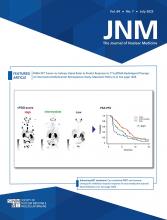A 55-y-old man underwent [68Ga]Ga-fibroblast activation protein inhibitor (FAPI) PET/CT because of persistent pulmonary symptoms after recovery from coronavirus disease 2019 (1). No increased pulmonary tracer uptake was found; however, as shown in Figures 1A and 1C, focally increased [68Ga]Ga-FAPI uptake was observed in a mass within the dorsal musculature of the left thigh. Tracer uptake colocalized with a sharply circumscribed, inhomogeneously contrast-enhancing mass on MRI without relevant diffusion restriction (Fig. 1B).
Images of tenosynovial giant cell tumor (arrows). (A, B, and C) Axial [68Ga]Ga-FAPI PET/CT (A) and maximum-intensity PET projection (C) showing increased pulmonary tracer uptake. (B) Axial MRI showing colocalization of uptake with enhancing mass. (D) Hematoxylin- and eosin-stained histologic section showing tenosynovial giant cell tumor.
Consequently, CT-guided percutaneous biopsy was undertaken, and an aggressive angiomyxoma was suspected, a rare tumor affecting predominantly female patients and typically occurring in the perineum or pelvis (2). Although generally benign, this tumor grows infiltratively and is prone to recurrence.
Because of the proximity to the sciatic nerve, the tumor was completely resected in July 2021. The tumor showed a fine capsule encased by multiple layers. Subsequent to the operation, pathologic reassessment showed a definite diagnosis of a tenosynovial giant cell tumor (Fig. 1D), which is extremely rare in this location. Tenosynovial giant cell tumor is an unusual primary soft-tissue tumor that is completely distinct from and should not be confused with any giant cell–rich tumor of bone or soft tissue. Tenosynovial giant cell tumor belongs to the group of benign fibrohistiocytic tumors (3).
This report demonstrates the high sensitivity of [68Ga]Ga-FAPI PET/CT to detect previously unknown tumors, making it a promising test in cases of suspected tumor disease or in cancers of unknown primary (4).
DISCLOSURE
Wolfgang Fendler reports fees from SOFIE Bioscience (research funding), Janssen (consultant, speakers’ bureau), Calyx (consultant), Bayer (consultant, speakers’ bureau, research funding), Parexel (image review), and AAA (speakers bureau) outside the submitted work. Ken Herrmann reports personal fees from Bayer, Sofie Biosciences, SIRTEX, Adacap, Curium, Endocyte, BTG, IPSEN, Siemens Healthineers, GE Healthcare, Amgen, Novartis, ymabs, Bain Capital, and MPM Capital; nonfinancial support from ABX; grants from BTG; and other fees from Sofie Biosciences outside the submitted work. Christoph Rischpler reports speaker honoraria from Adacap, Alnylam, BTG, Curium, GE Healthcare, Pfizer, Siemens Healthineers; a consultancy for Adacap and Pfizer; and a research grant from Pfizer, all outside the submitted work. No other potential conflict of interest relevant to this article was reported.
Footnotes
Published online Jan. 26, 2023.
- © 2023 by the Society of Nuclear Medicine and Molecular Imaging.
- Received for publication December 19, 2022.
- Revision received December 22, 2022.








